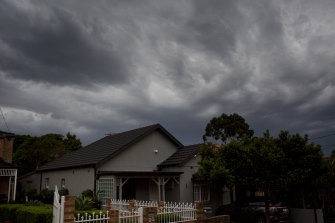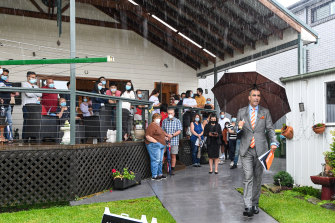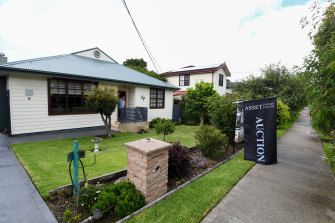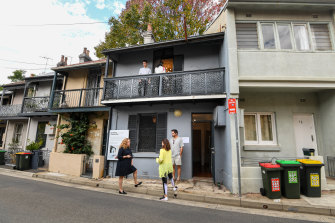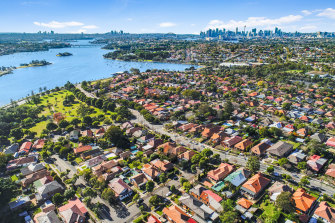Talking points
- Rising interest rates mean home buyers can borrow less money and bid less at auction, pushing prices down.
- If home prices rise a little further and then fall, they could be back to current levels or last year’s levels by 2024.
Property listings
Where would property prices be if they rise a little further and then fall slightly over the next couple of years, as economists expect?
Home prices could end up close to current levels or back at the same level as last year, but with the kicker that mortgage repayments will be more expensive.
Looming interest rate rises will constrain how much home buyers can borrow.Credit:Ryan Stuart
Once the Reserve Bank lifts the cash rate – perhaps as early as June or as late as 2023 – home buyers will be able to borrow less, which could constrain how much they can bid at auction and push prices down.
The forecasts come after home values soared in the pandemic, as locked-down buyers armed with crisis-era interest rates chased more spacious accommodation to work from home.
Sydney home values were already high relative to wages and then jumped 25.3 per cent in 2021 to a median $1.098 million, on CoreLogic figures that include both houses and apartments. Melbourne rose 15.1 per cent to a median of $795,000, while the national median rose 22.1 per cent to almost $710,000.
The jump famously surprised economists, who had expected a deep recession and dwelling price falls of as much as 20 per cent, before stimulus measures and effective social distancing came to the rescue.
If home buyers can’t bid as much, it could be a rainy day for property prices. Credit:Peter Rae
Professional property buyers warn serious purchasers against trying to pick the peak and trough of the market, due to the risk of missing out if conditions turn.
ANZ last week predicted average capital city housing prices to rise about 8 per cent this year and fall about 6 per cent in 2023.
Sydney is tipped to rise 9 per cent and fall 7 per cent, while Melbourne is set to rise 5 per cent and fall 6 per cent.
The strong gains of last year are unlikely to be repeated in 2022, the bank warned, due to higher mortgage rates, constrained affordability, and a clampdown from the bank regulator that is already reducing the maximum amount buyers can borrow. A return of demand from immigrant buyers is not expected to be enough to trump the increased cost of borrowing.
ANZ expects the cash rate to start rising in September and reach 2 per cent by the end of 2023, but predicts property price falls would only be modest compared to the run-up over the past two years.
If this forecast played out, home values would finish 2023 barely changed compared to the end of 2021, with Sydney just $15,000 higher at $1.113 million and Melbourne $10,000 lower at about $785,000.
ANZ senior economist Felicity Emmett expects a soft landing for the property market as prices peak this year and fall next. But the buying landscape may look different in two years with a higher cash rate.
“By the end of 2023 prices are going to end up close to where they are now,” she said.
Home values have soared and are likely to rise a little further before falling.Credit:Peter Rae
Though property prices would ease as interest rates rose, reduced borrowing power would also make it harder for some to get into the property market, Ms Emmett said.
Westpac is a little more downbeat on prices and tips the cash rate to start rising in August, eventually reaching 1.75 per cent.
Home values are set to rise just 2 per cent this year, fall 7 per cent in 2023 and a further 5 per cent in 2024 before stabilising, the bank expects.
But in Sydney and Melbourne, dwelling prices are tipped to finish this year flat and drop 9 per cent next year, with further falls in 2024 of 5 per cent for Sydney and 6 per cent for Melbourne.
Buyers are set to face higher mortgage repayments.Credit:Peter Rae
That would leave Sydney median values just under $1 million by the end of next year and about $950,000 by the end of 2024, while Melbourne would sit at about $723,000 next year and $680,000 by late 2024.
The bank said prices at the end of 2024 would be on par with their level in April last year.
Westpac senior economist Matthew Hassan said the bank’s surveys showed most consumers were only expecting 50 basis points of rate hikes and had not yet realised how high interest rates were likely to climb.
Once they realised, that could halt property price growth, although Sydney and Melbourne could see steeper falls than relatively affordable cities such as Brisbane and Adelaide.
“Initially, the move higher in interest rates dominates the affordability picture,” he predicted.
“As we move through the price correction into 2023 and 2024, once rates stabilise we do get some improvement in affordability. It’s probably only going to be if and when an easing cycle materialises we’ll see an affordable market.”
Wage rises could help potential home buyers, but the effect would only be marginal.
NAB economists expect the cash rate to rise from November and a turning point for property prices in the second half of this year.
Overall dwelling prices are tipped to rise 3 per cent this year and fall 10 per cent next, with Sydney to rise 1.9 per cent and Melbourne to rise 1.2 per cent this year, and both cities to fall 11.4 per cent in 2023.
This would leave Sydney values about $107,000 lower by the end of next year, at just over $991,000. Melbourne values would be $82,000 less, at about $713,000.
“We do not see these declines as disorderly, with the labour market remaining strong, wages growth picking up and rates still relatively low – though steadily increasing,” NAB Group chief economist Alan Oster wrote in a recent note to clients.
Commonwealth Bank head of Australian economics Gareth Aird made headlines last week when he tipped the cash rate to start rising from June.
Housing prices could fall, but they might not be more affordable at first.
He had been thinking dwelling prices would rise 7 per cent this year, but will now reassess. He still expects a 10 per cent fall once prices peak.
“What ends up happening to home prices will be dictated by what happens when the Reserve Bank ends up moving interest rates,” he said.
“The earlier they lift the cash rate the earlier that’s going to mark the peak.”
He noted that Sydney and Melbourne home values have been holding broadly steady in February so far, as measured by the daily CoreLogic index, adding one month did not make a trend, but tentative evidence was emerging that prices were close to peaking in the largest capitals.
If wages rise as the Reserve Bank hopes, that could help borrowers repay their loans, but the increase in interest rates would have a bigger impact than the increase in wages, he said.
With Kate Burke
Most Viewed in Property
Source: Read Full Article

